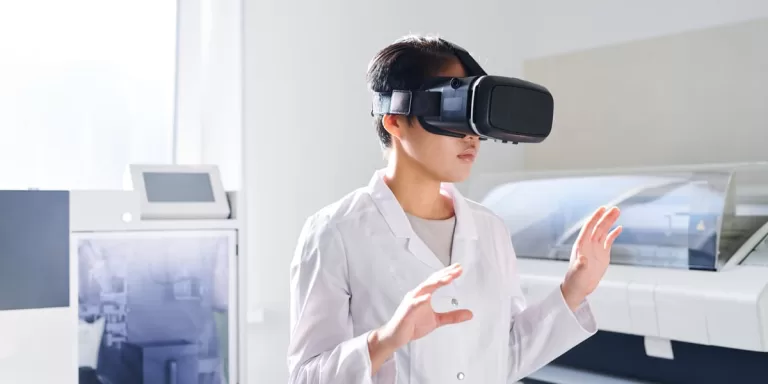If decades ago someone had told you that you could have the opportunity to train your employees in a realistic, safe and controlled environment before they ever set foot in the factory or enter a customer-facing role, you might not have believed them one bit. But in 2022 this is more than possible, that’s the power of virtual reality.
Imagine being able to immerse yourself in a realistic, three-dimensional simulation of the work environment you will be in once you are hired. No more awkward on-the-job training where you have to make mistakes to learn. With virtual reality (VR), employees can make those mistakes in a safe, controlled environment before ever stepping foot on the factory floor or engaging in dangerous practices. This is just one of the many advantages of using VR for training in industries such as manufacturing, healthcare, and construction.
This trend is being driven largely by advances in technology, as well as a growing awareness of the benefits of VR for employee training in a variety of industries.
Benefits of VR training
VR training simulations offer a number of advantages over traditional methods, such as on-the-job training, apprenticeships and even computer-based training. VR simulations are more engaging and immersive, which helps employees retain information better. They can also be designed specifically for each individual, which means employees can receive exactly the training they need to do their jobs well according to their capabilities. And because VR simulations can be reused over and over again, companies can save money in the long run by not having to constantly create new training materials.
Safety first
One of the most important advantages of VR for the industry is that it allows employees to practice potentially dangerous tasks in a safe environment. For example, employees can train in the proper handling of chemicals or operation of machinery without ever coming into contact with actual hazardous materials or endangering themselves or others. In addition, if an employee makes a mistake during VR training, the consequences are not real and can be easily corrected, unlike in the real world, where a mistake can result in serious injury or even death.
Improving engagement and retention
Another big advantage of VR for employee training is that it can improve engagement and retention rates. Studies have shown that people retain up to 90% of what they learn when using VR, compared to only 10-20% when learning with traditional methods such as reading manuals or listening to lectures.
In addition, VR training can be more engaging and fun than traditional methods, which means employees are more likely to stick with a training program, complete it, and integrate into the company by valuing its sense of differentiation.
Cost-effective
VR training is also cost-effective compared to traditional methods, such as on-the-job training (OJT). With on-the-job training, employees must take time away from their job duties while receiving training, which can result in lost productivity. In addition, on-the-job training often requires more manpower, as someone needs to be available at all times to deliver the training and answer questions. With VR training, employees can complete their training on their own time without affecting their work tasks, and without requiring additional manpower from supervisors or managers.
Examples of successful VR training programs
Several companies are already using VR to train their employees with great success. Walmart, for example, has been using VR simulations to train its employees since 2017. The company uses Oculus Go headsets to transport employees to a simulated store where they can practice things like dealing with difficult customers and handling unexpected situations like power outages.
So far, Walmart has found that its VR training programs have helped employees retain up to 20% more information than with traditional methods, such as lectures or role-playing exercises.
Another company that is successfully using VR for employee training is Airbus. The aerospace manufacturer uses Oculus Rift headsets to train its assembly line workers to build aircraft wings.
The company found that using VR for this type of hands-on training helped workers perform their tasks up to 33% faster than when using traditional methods such as manuals and 2D computer screens. In addition, the number of errors made by workers who had been trained using VR simulations decreased significantly.
The major benefits of using virtual reality in employee training are numerous. From improved safety and engagement to increased retention and cost savings, VR provides industry with a powerful employee development tool that is revolutionizing the way employees are trained in a variety of industries worldwide.
Are you ready to take your employee training programs to the next level? If so, now is the time to consider incorporating VR into your employee development strategy, before the competition does it first. Contact us!
